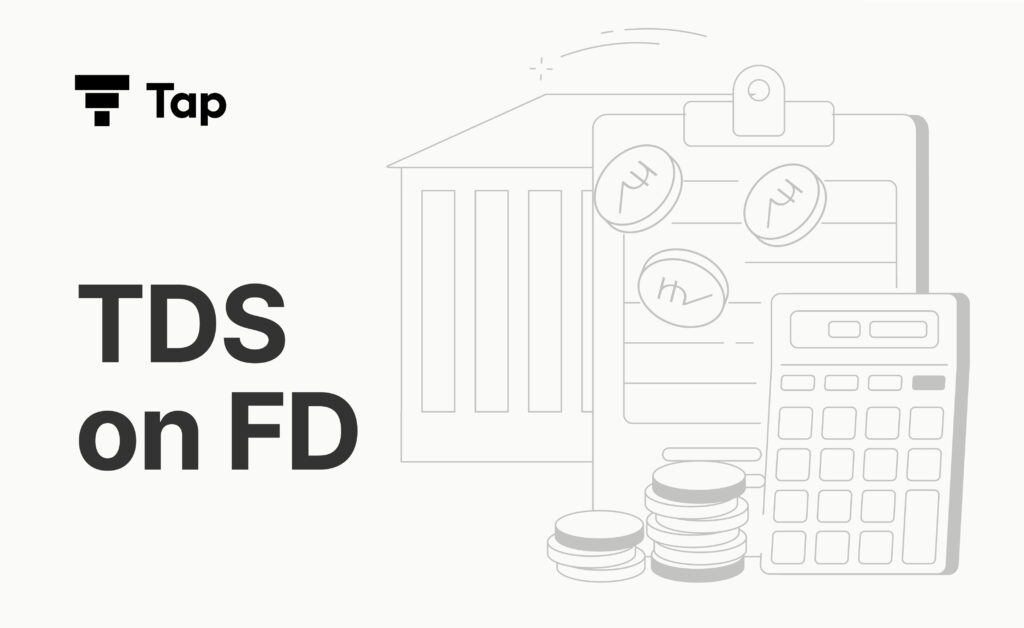Navigating TDS on Fixed Deposits

Fixed Deposits (FDs) are like safe harbors for your money, offering stability and guaranteed returns in India. But, there’s a hidden challenge: understanding and dealing with Tax Deducted at Source (TDS) on FD interest. In this straightforward guide, we’ll break down the complexity, helping you make the most of your FD returns while keeping tax issues at bay.
FDs provide a safe place for your money, but the interest you earn isn’t tax-free. It gets added to your total taxable income under ‘Income from Other Sources.’ However, you don’t pay this tax directly. Banks act as tax collectors, automatically deducting a part of your interest if it exceeds Rs. 40,000 (Rs. 50,000 for senior citizens) annually. Understanding TDS is more than just knowing rates and thresholds.
Here are the key points:
– Post-Tax Return Reality: The 10% TDS increases your income, potentially pushing you into a higher tax bracket and lowering your adequate returns.
– Balancing FDs with Other Investments: Experts suggest diversifying with investments like mutual funds to balance the impact of tax on FD interest.
– Calculation Made Simple: TDS is a partial tax payment. The final tax is calculated by adding the interest to your total income and applying your applicable tax rate. Reporting all earned interest ensures accurate tax assessment.
Beyond understanding TDS, consider these
strategies for maximising your FD returns:
– Stay Exempt: Keep your total interest income below Rs. To avoid TDS, 2.5 lakh or submit Form 15G/15H to the bank.
– Diversify Your Portfolio: Don’t rely solely on FDs. Explore market-linked instruments like mutual funds for potentially higher returns.
– Choose the Right Tenure: Interest rates vary with tenures. Match your maturity needs with the optimal rate.
Special Provisions for Seniors and Housewives:
Seniors: An increased exemption limit of Rs. 50,000 allows tax-free FD returns longer. Simplified Form 15H facilitates claiming TDS exemption without providing income details.
Housewives: While housewives may not have an independent income, interest earned on FDs in their name is taxable. They can file clubbed ITRs with their spouses and benefit from their spouse’s income slabs.
Real-Life Scenarios: How TDS Plays Out:
Let’s look at practical examples:
Case 1:
Mr Sharma, a retired teacher, has placed his savings in multiple FDs across different banks. While each individual FD’s interest falls below the Rs. 40,000 threshold for TDS deduction, the combined annual interest from all his FDs adds up to Rs. 45,000. Unfortunately, Mr. Sharma isn’t aware of the cumulative TDS rule. As a result, his bank deducts 10% TDS on the entire Rs. 45,000, leaving him surprised and slightly shortchanged. This scenario highlights the importance of understanding how TDS applies to combined FD interest across banks.
Case 2: Young Couple’s Investment Balancing Act
Anuj and Priya, a young couple with ambitious financial goals, decide to diversify their portfolio. They invest Rs. 5 lakh in an FD for stability and Rs. 3 lakh in a mutual fund for the potential for higher returns. While the FD interest of Rs. 40,000 triggers a TDS deduction, the mutual fund investment offers tax-saving benefits through SIPs. By strategically balancing their investments, they optimise their returns while keeping the taxman at bay.
Case 3: Senior Citizen’s Tax Advantage
Mrs Agarwal is a senior citizen with an annual income of Rs. 3.5 lakh, invests Rs. 2 lakh in an FD offering a senior-friendly interest rate. Her FD interest of Rs. 16,000 falls well below the Rs. 50,000 exemption limit for senior citizens. With Form 15H submitted to her bank, she enjoys the full returns on her FD without any TDS deduction. This scenario demonstrates the tax benefits available to senior citizens regarding FD interest income.
FAQs: Answering Common Questions
1. Do I need to pay TDS on all FD interest?
Only if your total interest income from all FDs exceeds Rs. 40,000 (Rs. 50,000 for seniors) in a financial year.
2. What if the bank doesn’t deduct TDS from my FD?
You’re still liable to pay tax on the entire interest earned. Report the income and pay due tax during ITR filing.
3. Can I claim a refund if the bank deducted too much TDS?
Yes, by filing a revised ITR with proof of actual income.
4. Can I break my FD early to avoid TDS?
Breaking your FD early usually incurs penalties, which may outweigh the tax benefit. Consider other tax-saving options.
5. How can I track my TDS deduction on FDs?
Banks provide an annual statement with all TDS deductions. Check your online banking portal, too.
Fixed Deposits (FDs) remain a staple for stability in India, but dealing with Tax Deducted at Source (TDS) can be tricky. This guide simplifies the process, helping you maximise returns while staying tax-smart.
Recent Stats:
– As of April 2023, the 10% TDS threshold for individuals is Rs. 40,000 yearly and Rs. 50,000 for seniors.
– Over Rs. 1 lakh crore was collected through TDS on bank deposits in 2022-23, showing its significance.
– Nearly 40% of investors are unaware of TDS intricacies, emphasising the need for financial literacy.
Conclusion: A Simple Takeaway
Navigating TDS on FD interest requires knowledge, planning, and proactive action. Equip yourself with the insights in this guide to ensure your FD investments work for you, optimising returns while staying on the right side of the taxman. Remember, a little financial literacy ensures your financial ship sails smoothly through the sometimes choppy waters of TDS.
